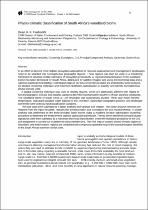JavaScript is disabled for your browser. Some features of this site may not work without it.
- ResearchSpace
- →
- Research Publications/Outputs
- →
- Journal Articles
- →
- View Item
| dc.contributor.author |
Fairbanks, DHK

|
en_US |
| dc.date.accessioned | 2007-01-22T06:25:56Z | en_US |
| dc.date.accessioned | 2007-06-07T10:05:04Z | |
| dc.date.available | 2007-01-22T06:25:56Z | en_US |
| dc.date.available | 2007-06-07T10:05:04Z | |
| dc.date.issued | 2000-07 | en_US |
| dc.identifier.citation | Fairbanks, DHK. 2000. Physio-climatic classification of South Africa's woodland biome. Plant Ecology, vol. 149(1), pp 71-89 | en_US |
| dc.identifier.issn | 1385-0237 | en_US |
| dc.identifier.uri | http://hdl.handle.net/10204/1436 | en_US |
| dc.identifier.uri | http://hdl.handle.net/10204/1436 | |
| dc.description.abstract | In an effort to develop more holistic ecosystem approaches to resource assessment and management, landscapes need to be stratified into homogeneous geographic regions. These regions can then be used in a monitoring framework to develop reliable estimates of ecosystem productivity. A regional characterization of the woodland biome has been developed for South Africa, delineated by satellite imagery and using environmental data and a rigorous statistical methodology. Distribution maps of key environmental variables are analyzed by factor analysis, an iterative clustering technique and maximum likelihood classification to quantify and identify homogeneous physio-climatic units. A spatial clustering technique was used to identify regions, which are statistically different with regard to five physiographic, climatic and edaphic variables deemed important within southern African savanna woodlands. The woodland biome of South Africa at one kilometre resolution was successively divided. Thirty year mean monthly temperature, total plant-available water balance of soil, elevation, landscape topographic position, and landscape soil fertility were used as input classification variables. The map data were submitted to a factor analysis and varimax axis rotation. The factor analysis removes correlations from the input variables, reduces the dimensionality, and normalizes the axis measurements. A cluster analysis was performed on the three principal factor scores using a modified iterative optimization clustering procedure to determine the finest level of classes statistically permitable. Twenty-seven identified unimodal cluster signatures were then submitted to a maximum likelihood classification where the statistical probability of the GIS cell assignment is carried out to determine class membership. The final map of custom physio-climatic regions is described, and these custom regions are compared with a vegetation potential map of the woodland types identified in the South African summer rainfall zone. | en_US |
| dc.format.extent | 224606 bytes | en_US |
| dc.format.mimetype | application/pdf | en_US |
| dc.language.iso | en | en_US |
| dc.publisher | Kluwer Academic Publishers | en_US |
| dc.rights | Copyright: 2000 Kluwer Academic Publishers | en_US |
| dc.subject | Abiotic variables | en_US |
| dc.subject | Ecoregions | en_US |
| dc.subject | GIS | en_US |
| dc.subject | Geographic information systems | en_US |
| dc.subject | Ecology | en_US |
| dc.subject | Forestry | en_US |
| dc.subject | Climatic variables | en_US |
| dc.subject | Savannas | en_US |
| dc.title | Physio-climatic classification of South Africa's woodland biome | en_US |
| dc.type | Article | en_US |
| dc.identifier.apacitation | Fairbanks, D. (2000). Physio-climatic classification of South Africa's woodland biome. http://hdl.handle.net/10204/1436 | en_ZA |
| dc.identifier.chicagocitation | Fairbanks, DHK "Physio-climatic classification of South Africa's woodland biome." (2000) http://hdl.handle.net/10204/1436 | en_ZA |
| dc.identifier.vancouvercitation | Fairbanks D. Physio-climatic classification of South Africa's woodland biome. 2000; http://hdl.handle.net/10204/1436. | en_ZA |
| dc.identifier.ris | TY - Article AU - Fairbanks, DHK AB - In an effort to develop more holistic ecosystem approaches to resource assessment and management, landscapes need to be stratified into homogeneous geographic regions. These regions can then be used in a monitoring framework to develop reliable estimates of ecosystem productivity. A regional characterization of the woodland biome has been developed for South Africa, delineated by satellite imagery and using environmental data and a rigorous statistical methodology. Distribution maps of key environmental variables are analyzed by factor analysis, an iterative clustering technique and maximum likelihood classification to quantify and identify homogeneous physio-climatic units. A spatial clustering technique was used to identify regions, which are statistically different with regard to five physiographic, climatic and edaphic variables deemed important within southern African savanna woodlands. The woodland biome of South Africa at one kilometre resolution was successively divided. Thirty year mean monthly temperature, total plant-available water balance of soil, elevation, landscape topographic position, and landscape soil fertility were used as input classification variables. The map data were submitted to a factor analysis and varimax axis rotation. The factor analysis removes correlations from the input variables, reduces the dimensionality, and normalizes the axis measurements. A cluster analysis was performed on the three principal factor scores using a modified iterative optimization clustering procedure to determine the finest level of classes statistically permitable. Twenty-seven identified unimodal cluster signatures were then submitted to a maximum likelihood classification where the statistical probability of the GIS cell assignment is carried out to determine class membership. The final map of custom physio-climatic regions is described, and these custom regions are compared with a vegetation potential map of the woodland types identified in the South African summer rainfall zone. DA - 2000-07 DB - ResearchSpace DP - CSIR KW - Abiotic variables KW - Ecoregions KW - GIS KW - Geographic information systems KW - Ecology KW - Forestry KW - Climatic variables KW - Savannas LK - https://researchspace.csir.co.za PY - 2000 SM - 1385-0237 T1 - Physio-climatic classification of South Africa's woodland biome TI - Physio-climatic classification of South Africa's woodland biome UR - http://hdl.handle.net/10204/1436 ER - | en_ZA |






